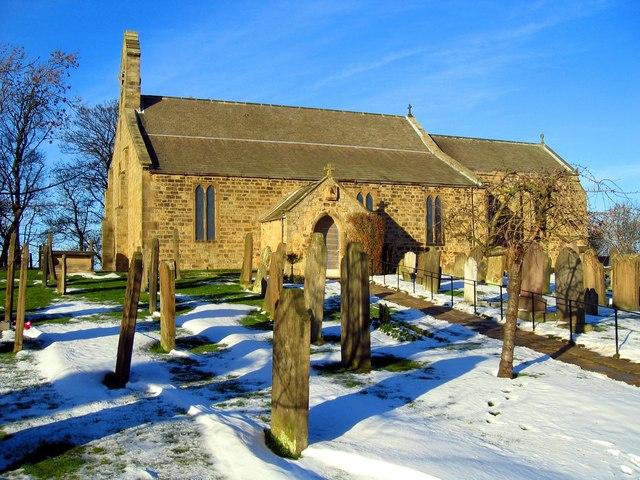Holy Cross
Ryton, Northumberland
Built in 1220 in Early English style with an impressive spire added 1360.

The church of St Andrew is situated in the centre of the village on a hill top opposite the Swan Inn, it was consecrated in 630 and still retains many Saxon and later Norman elements.
Heddon on the Wall, Northumberland
Here there are fragments of a 7th century Anglo Saxon church with a Norman sanctuary. he original church was probably built in AD680. The original nave occupied space now taken up by the two easternmost bays of the present nave. The apsidal chancel occupied what is the now the choir and a little of the Norman chancel.
Of this church little remains. Some of the masonry in the walls of today’s choir is undoubtedly Saxon. There is also Anglo Saxon long and short work and just visible on the gable of the south aisle the old roof line can be seen. Finally, there are blocked Anglo Saxon windows within the choir fabric.
In 1165 the monks of Blanchland Abbey were given the lands around Heddon and assumed responsibility for its church. They demolished the apse and built the existing sanctuary. It cannot have been very long before the aisles were added and church extended westwards because the rest of the church is decidedly Early English in character. Pevsner puts the north aisle at about 1200. A little later the south aisle was built and the nave remodelled with a third bay extending the nave westwards.
That seems to have been about it until as recently as the 1840s when there was further extension westwards with a fourth bay being added to the nave. The windows in the north aisle were replaced in 1839 in a pseudo Early English style that did nothing to damage the pleasing appearance of this church. There has never been a tower here.
There are some other curiosities here. Over each of the two pairs of Early English windows in the south side of sanctuary there is a little head set into a recess above. Beneath the Norman window in the sanctuary is the head of a stone cross that was found beneath the vestry floor. It is now believed to be an Anglo Saxon preaching cross.
There are two decorative capitals on the north arcade. Such chunky capitals would be unusual in an Early English arcade and the decorations do not look at all late Norman. They were possibly recovered from a disused Roman building.
Ryton, Northumberland
Built in 1220 in Early English style with an impressive spire added 1360.
Whorlton, Tyne & Wear
Whoever you are, and whatever your position or perspective, you'll find a welcome here.
Ovingham, Northumberland
In an attractive village beside the River Tyne lies St Mary the Virgin, graced by a magnificent late Saxon tower.